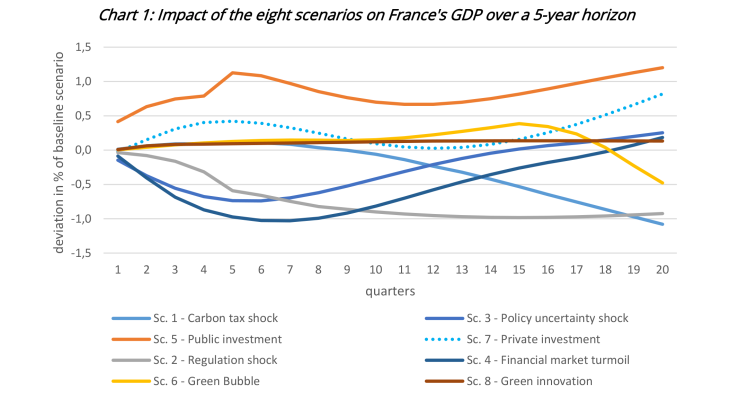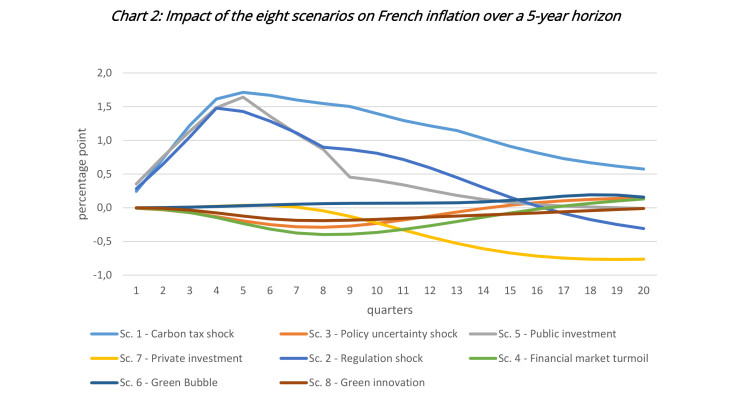There is as yet no consensus on the macroeconomic consequences of transition policies. They will depend on the scale and timing of political decisions, and on the reactions of economic agents. On the one hand, it is difficult to predict the measures that will be implemented: the development of carbon pricing remains uncertain, estimates of the amount of investment needed for the transition vary and there is little consensus on how it will be financed. Furthermore, it remains difficult to anticipate changes in the behaviour of economic agents (consumers, financial players). Given these uncertainties, we have developed eight short-term scenarios (see Allen et al., 2023 for the methodology and the scenario database for the detailed data) to study how the various disruptions associated with the transition may affect growth, inflation and financial stability over a five-year horizon. These disruptions, which take the form of energy policies, investment booms, financial turbulence and innovation, are not mutually exclusive. Nevertheless, distinguishing between them provides a better understanding of the economic mechanisms at work: each scenario can be a simplified aspect of a more complex transition trajectory.
The economic consequences of these scenarios are estimated using a suite of models (see Allen et al., 2020, 2023) that includes New Keynesian macroeconomic models - NiGEM for the international part, FR-BDF for France (see Lemoine et al., 2020) - and a multi-country sectoral model (see Devulder and Lisack, 2020). The calibration of each scenario requires devising assumptions on the evolution of the models' key variables (fossil fuel tax, cost of capital, credit spreads, productivity, etc.), inspired in part by the NGFS scenarios. The simulations show significant effects over a 5-year horizon after the start of the scenario, between -1.1% and +1.2% on France's GDP depending on the scenario, and between -0.8 p.p. and +0.6 p.p. on inflation. The difference between these projections illustrates the volatility and uncertainty that the transition may induce in the short-term cycle.
Focus on three types of economic disruption linked to transition
We present here the results for France of simulations of three types of scenario: i) sudden introduction of environmental regulations, ii) financial turbulence linked to the sudden change in the valuation of carbon assets ("stranded" assets), and iii) investment policies in favour of transition.
A scenario involving the sudden and unanticipated introduction of strict limits on the quantities of fossil fuels consumed (scenario 2, inspired by the "Fit-for-55" European plan, but with targets set five years earlier), accompanied by subsidies for renewable energies, would lead to significant sectoral distortion. The aggregate effect in the short term would be negative, as the sudden restrictions would put an abrupt brake on activity, while the subsidies for renewable energies would take time to change production processes. GDP would fall by 1% over a two-year horizon compared with a scenario without a transition policy, due in particular to the additional effect of the drop in foreign demand. Subsidies would only partially offset these recessionary effects, and more so at the end of the horizon. Inflation would be higher in the short term (up 1.5 p.p. one year after the start of the scenario) but would then decline.
The transition could also involve a devaluation of assets depending on their exposure to changes in environmental legislation or technologies (scenario 4). This scenario would lead to a sharp fall in stock market indices (down 23% from the start of the scenario). In addition, GDP would drop by 1% after five quarters after the start of the scenario, but France would be less affected than countries such as the United States or Canada, which have a higher proportion of stranded assets.
A third scenario could involve a rapid increase in corporate investment, generated here by subsidies to the private sector financed by a rise in household taxes (scenario 7). This scenario is partly based on International Energy Agency projections of the additional annual investment needed to achieve carbon neutrality by 2050 (1.2 GDP points for France), which is lower than the amount estimated by J. Pisani-Ferry and S. Mahfouz in their recent report (2.3 GDP points). This trajectory leads to productivity gains and an increase in production, with no significant crowding-out effect between investments. However, the impact on GDP is weak at the start of the horizon due to the fall in household consumption. At the end of the horizon, on the other hand, productivity gains result in a 0.8% rise in GDP and disinflationary effects.
The five other scenarios offer variants that differ according to the assumptions made about transition policies or economic agents' behaviour. Presented in detail in Allen et al. (2023), they provide a range of plausible effects on growth and inflation.

